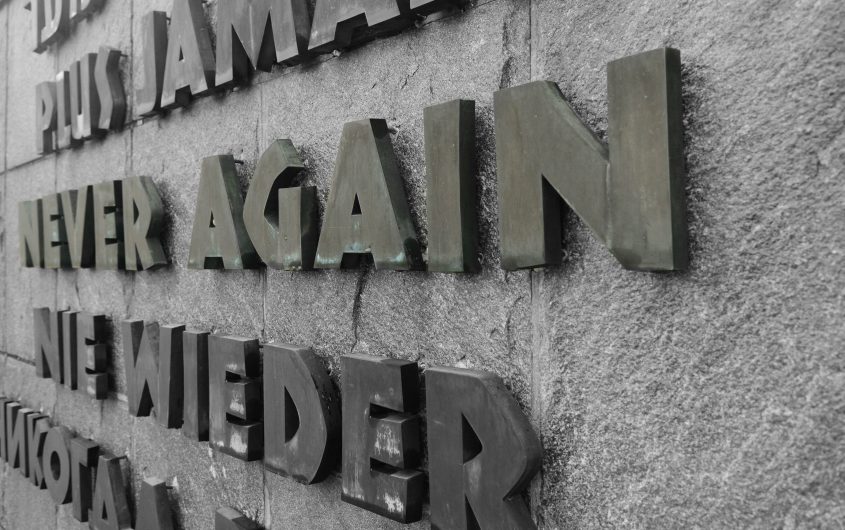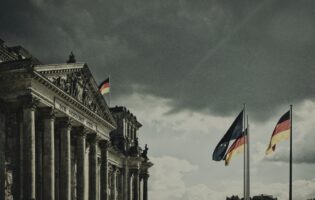
Us versus Them: The Steady Narrative of “Othering” in Historical and Contemporary Debates in Germany and the U.S.

Ufuk Topkara
Humboldt University Berlin
Dr. Ufuk Topkara is Visiting Professor of Comparative Theology in an Islamic Perspective at the Berlin Institute for Islamic Theology, Humboldt University Berlin.
Dr. Topkara was a DAAD/AICGS Research Fellow from October to December 2018. He has been active in promoting inter-religious dialogue since 2005 as an expert on Islam for the Evangelical Academy Berlin, as a member of the Jewish-Turkish Roundtables for Dialogue, and with the Catholic Academy Berlin. Dr. Topkara was a Tour Guide at the Jewish Museum of Berlin from 2005 to 2015. He was a Humanity in Action Fellow in New York and worked in the U.S. House of Representatives as a Humanity in Action-Lantos Fellow in Washington, DC. He studied History and Philosophy at Humboldt University of Berlin and Harvard University. He completed his doctoral dissertation with the Graduate School of Islamic Theology at the University of Paderborn, Germany, analyzing the convergence of reason and faith in Islam.
While at AICGS, Dr. Topkara will conduct research on a project that emerges out of the interconnected strands of intellectual inquiry: comparing the experiences of discrimination faced by Jews in early twentieth century Germany and the experiences of discrimination faced by Muslims in contemporary Germany. By drawing parallels between the marginalization faced by these two religious minority groups, Dr. Topkara will provide a tool for combating rising anti-Semitism and anti-Muslim sentiment in both Germany and the United States today.
Dr. Topkara intends to showcase patterns of marginalization and othering of religious minorities in contemporary German society. A comparison between the Jewish community of the early twentieth century in Germany and contemporary Muslim community in Germany is particularly promising because of the inherent questions of belonging. Similar to the experience of German Jews in early modern times, German Muslims nowadays struggle with locating their place within German society. In both cases, the religious minority brought up questions of belonging that goes beyond citizenship, that is, the inclusion if not appreciation of cultural and religious differences.
Germany and the United States today face rising anti-Semitism and anti-Muslim sentiment as nativist politics on both sides of the Atlantic gain not only traction, but also legitimacy. From the desecration of synagogues and mosques to hate crimes against both religious minority groups, Jews and Muslims are being confronted with high levels of cultural othering.[1] The world has been shocked by the shooting at a Pittsburgh synagogue, the murder of a Holocaust survivor in France, and far-right movements that call for white supremacism. Even the swastika has been revitalized as a symbol decrying diversity. Fear is rampant, everywhere.
Othering has proven time and again to be a kind of default state that societies revert to when they are confronted with cultural, social, and economic change.
At the same time, larger questions regarding the role of religious and cultural diversity in Western societies have arisen in both countries at this time of deepening social divisions. While the need to protect the autonomy of the individual has been increasingly recognized both socially and legally since the anthropological turn in philosophy at the end of the eighteenth century, the notion of how to establish a truly pluralistic society remains unclear. Othering has proven time and again to be a kind of default state that societies revert to when they are confronted with cultural, social, and economic change. The recognition of difference does not have to carry a negative connotation per se. Plurality is not something to be feared. A society should be robust enough to accommodate difference while upholding a set of shared values.
The Holocaust was among the greatest breeches in the accommodation of difference, instead demonizing Jews and other minorities. In the aftermath of World War II, West German society developed a widespread sense of belonging, which Habermas famously called “Verfassungspatriotismus,” constitutional patriotism. This consensus slowly deteriorated after the reunification of Germany, as East and West grappled to build new social bridges and deal with economic inequalities, leaving behind a social vacuum. Yet German society was bound by the promise of “never again.” With the memory of the Holocaust came a particular sensitivity toward the history of discrimination and othering in Germany. As a recent survey showcased, however, the memory of the Holocaust is fading especially among young adults; as the last generation of Holocaust survivors grows old, fewer and fewer people can relate to the sense of responsibility that arose in its aftermath.[2] Many would like to leave the past behind. Certainties that once not only shaped West Germany’s reputation in Europe and the world, but were also woven into the fabric of a postwar generation, seem to be coming into question.
As the German Jews in early modern times, Muslims and Jews alike today struggle with locating their place within German and American societies. In both cases, these religious minorities rouse questions of belonging that goes beyond legal citizenship to cultural citizenship: that is, belonging not only vis-à-vis the laws of the land, but also in the imagined community of the nation.
Despite widespread stereotypes that Muslims are to blame for the resurgence in anti-Semitism in contemporary western societies, research clearly shows that mainstream German and American societies alike still hold substantial levels of anti-Semitic sentiment, in addition to anti-Muslim sentiment. There is a worrying tendency within German society, and increasingly in the U.S. as well, to build national identity negatively rather than positively, which results in the exclusion of minority groups. Fighting anti-Semitism and anti-Muslim sentiment, consequently, first requires a firm analysis of their underlying causes. The current debate in Germany largely focuses on “the Muslim question,” i.e., whether Islam can belong to Germany. While the Judeo-Christian influence is being positively identified as the source of European and German identity, Islam is juxtaposed as an antagonistic entity, supposedly fueling division.
There is a worrying tendency within German society, and increasingly in the U.S. as well, to build national identity negatively rather than positively, which results in the exclusion of minority groups.
It is impossible to understand the present without grasping historical ghosts and trajectories. The “Muslim question” is, however, not altogether unrelated to the “Jewish question” of the twentieth century; that is, both are very much European questions of national identity, accommodating, and upholding equality. At the same time, no neat or exact historical comparisons can be made. Today is another time, one that is perhaps not divorced from the past, but also not predetermined by it. However, to understand the hold of both anti-Semitism and anti-Muslim sentiment requires a reflection on Europe’s history of othering. Anti-Semitism is deeply ingrained not only in Germany, but in the broader European imagination. From being marked with a yellow sign to living in the ghetto of Warsaw, Jews were long identified as negatively distinct from broader Christian European society. Harkening back to the Reconquista reveals a time in which individuals were expelled or murdered if they had a single drop of Jewish (or Muslim) blood. Even conversion could not save them from these paths. In post-Holocaust modernity, such differentiation remained in spite of the disappearance of physical markings, ghettos, or explicit persecution. Many leading Jewish intellectuals of the twentieth century reflected on an enduring position of otherness in their work. For example, Zygmunt Bauman argues, European Jews in modernity were no longer exiled or ghettoized, but seen to threaten the European order. Bauman scholar Marotta writes, “The ‘conceptual Jew’ threatened the temporal and spatial boundaries of Christianity and the new secular modern world. The ‘conceptual Jew’ epitomizes, for the secular modern world, all that is slimy and all that defies the order of things.”[3]
If not the “Jewish question” nor the “Muslim question,” what question am I attending to here? One that is increasingly on the minds of Americans and Europeans alike: whether the experiences of Jews and Muslims today reflect those of Jews in early twentieth century Europe, which led to the human catastrophe of the Holocaust? Aside from the methodological challenges that a comparison between different time periods presents, a thorough examination of the historical circumstances remains indispensable to better understanding the harsh realities that both Jews and Muslims face today. That is, we can learn from history.
While many seminal works have shed light on numerous aspects of the rise and reign of anti-Semitism in Germany in the twentieth century, some historical sources remain understudied. The files of the Central Association of German Citizens of Jewish Faith (Centralverein deutscher Staatsbürger Jüdischen Glaubens, C.V.) in the period from 1933 to 1935 are of particular value for expanding our understanding of the societal forces of discrimination. The archives at the U.S. Holocaust Memorial Museum in Washington, DC, reveal the experiences of German Jews in the years before the Holocaust, providing an illuminating perspective of the persecuted populace.[4] In the letters exchanged, in their own words, we have a window into the human experiences that shaped the pre-Holocaust era, as well as attempts to resist widespread, dangerous othering.
The C.V. files contain not only reports by the branches of the Centralverein, which were sent to the headquarters in Berlin, but also the correspondence of individuals describing their experiences. They include Centralverein policy strategies aimed at fighting discrimination. An analysis of the various discriminatory practices directed at the Jewish community in this period—and the community’s reactions—can help to address the question of whether contemporary forms of anti-Semitism can be deemed a historical recurrence.
This approach essentially allows us to identify similarities and differences, to trace lasting threads and tropes of anti-Semitism across time, and to learn from the past in facing the challenges of the present and the future. In the context of this essay, it simply impossible to present even a cursory look of the findings. Instead, I will focus on a particular moment to paint a picture of challenges at the time and to suggest a parallel faced today:
While the official representatives of the C.V. were fully aware of the critical change that occurred with the rise of the Nazis to political power, in 1933 many members of the German-Jewish community voiced fundamentally different concerns in their letters to the headquarters. The Nazis’ rise to power was closely monitored not only by European societies, but by the United States as well. Many protests were organized by Jewish communities across multiple cities in the U.S. and Europe as they tried to raise awareness regarding the conceived threat of the National Socialist movement in Germany. The radical anti-Semitism that proliferated in Nazi circles was seen as a critical radicalization of already-known anti-Jewish policies. As odd as it may seem to a contemporary audience, some German Jews, however, felt inclined to denounce these international protests. The C.V. headquarters in Berlin received multiple letters urging the organization to uncompromisingly intervene in order to stop this “propaganda” that was tainting Germany’s reputation in the world.[5] The authors of these letters went even so far as suggesting to contact the Jewish communities personally in order to bring a swift end to the protests.[6]
In fact, some German Jews were referring in their letters to the necessary sacrifices German Jews ought to endure during an era of political turmoil and change.[7] The radical anti-Semitism of the Nazis was conceived by these individuals as a side effect of a larger, more important endeavour, that they felt attached to.
Undeniably, the Nazis were very successful and effective at othering the German Jews as the diametrically opposed entity to an imagined Germanness. This, on the other hand, stands in stern contrast to how German Jews felt. While we obviously cannot assume that this level of belonging to Germany was shared by any number of German Jews, it still provides us with an understanding of the depths of identification with the nation-state that prevailed even in the face of the radical anti-Semitism unleashed by the Nazis.
German Jews thought of themselves as Germans, just as American Jews and American Muslims, as well as German Jews and German Muslims, largely think of themselves as Americans or Germans today.
Reading these files reminded me of the words of a Holocaust survivor, who spoke to me about how deeply assimilated his parents, one a German Jew, were in society. “I didn’t know what it meant to be Jewish until the Holocaust.” It also reminds me of the words of second generation Muslims in Germany, such as one young man who said “we aren’t there yet, we can’t really be German.” In the early twentieth century, the “Jewish question” was a question asked by the mainstream, non-Jewish sectors of society. German Jews thought of themselves as Germans, just as American Jews and American Muslims, as well as German Jews and German Muslims, largely think of themselves as Americans or Germans today. Posed from the outside, such a question (whether the “Jewish question” or the “Muslim question”) forces the religious minority group to reconsider its belonging, breaking down a unifying imagination that recognizes plurality. Such externalization of an internal social reality of difference harms not only minorities, but society as a whole. It erodes the social contract, and the hope that plurality—in all of its colors and forms—will prevail over fear.
Supported by the DAAD with funds from the Federal Foreign Office (FF).
[1] Othering centers not only on differentiation, but on inferiority; that is, the “other” is perceived not only as different but lesser. Cf. Michal Krumer-Nevo and Mirit Sidi, “Writing against othering,” Qualitative Inquiry 18 (2012): 299.
[2] Benedikt Peters, “Nie vom Holocaust gehört,” Süddeutsche Zeitung, November 28, 2018; Cf. also “A Shadow over Europe,” CNN, 2018.
[3] Cf. Vince Marotta, “Zygmunt Bauman: Order, strangerhood and freedom,” Thesis eleven 70.1 (2002): 36-54, p. 46.
[4] Cf. United States Holocaust Memorial Museum Archives, RG-11.001M Fond 721. Records of the Centralverein deutscher Staatsbürger Jüdischen Glaubens, Berlin (Central Association of German Citizens of Jewish Belief, Berlin). 1923-1938.
[5] Cf. Records of the Centralverein at USHMM, 721-1-2566, F.22: Rabbi Dr. Goldbaum addressing the C.V., 30. March 1933.
[6] Cf. Records of the Centralverein at USHMM, 721-1-2292, F.36-7: Dr. Rosenthal, Advocate from Paderborn, addressing the C.V., 3. August 1933.
[7] Cf. Records of the Centralverein at USHMM, 721-1-2292, F.247-8: Kurt Alexander addressing the C.V., 23. March 1933.









